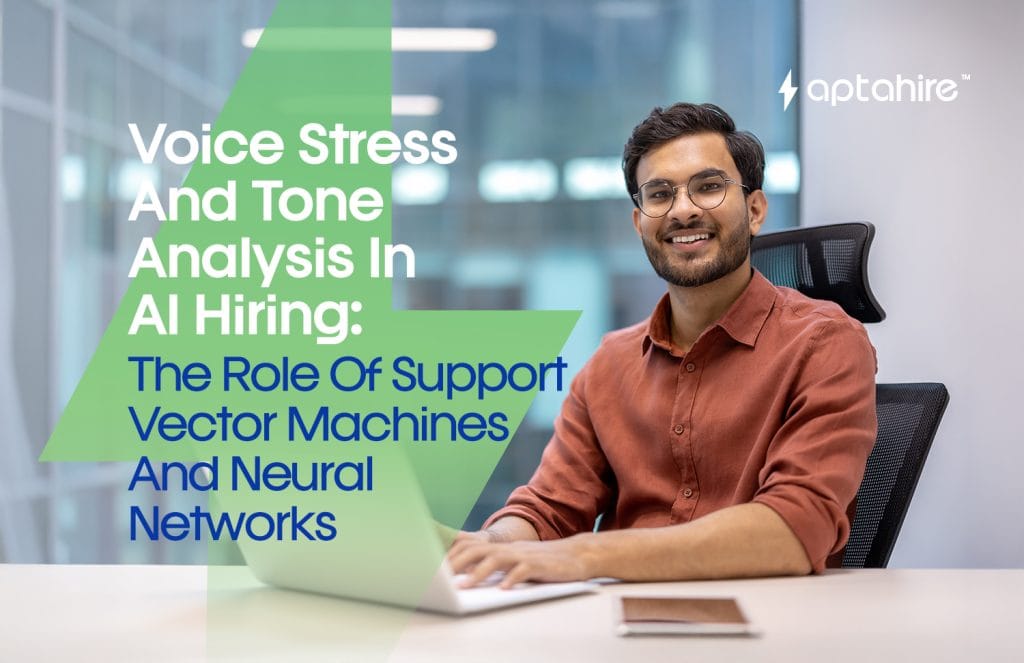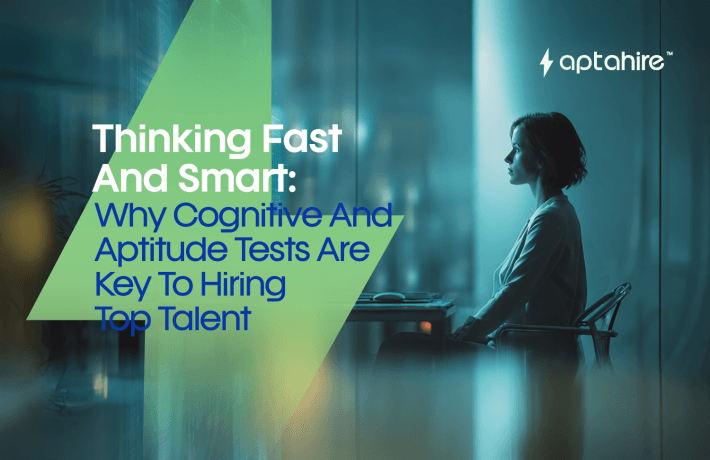Voice Stress and Tone Analysis in AI Hiring: The Role of Support Vector Machines and Neural Networks

Introduction
Imagine you’re conducting a virtual interview. The candidate answers smoothly, but you get a subtle gut feeling, something’s off. Maybe their tone is a bit strained, or their voice wavers slightly when discussing past challenges. Traditionally, experienced recruiters would rely on these instincts to gauge a candidate’s authenticity and emotional state. But as hiring shifts to digital platforms and scales up, relying solely on human intuition becomes impractical and inconsistent.
Enter Voice Stress and Tone Analysis, a fascinating intersection of psychology, linguistics, and artificial intelligence (AI). This technology leverages sophisticated machine learning models, particularly Support Vector Machines (SVMs) and Neural Networks, to analyze subtle changes in a candidate’s voice during interviews. These changes can reveal stress, confidence, emotional states, and even potential deception, enabling recruiters to make more informed hiring decisions.
This blog dives deep into how these AI techniques work, why they matter, and how they’re revolutionizing the hiring process.
What Exactly Is Voice Stress and Tone Analysis?
Before exploring the tech, let’s understand the basics.
When we speak, our voice carries more than just words, it conveys emotions, stress levels, confidence, and cognitive states. These vocal cues can be subtle:
- Pitch: The highness or lowness of the voice. Stress often causes pitch to rise.
- Speech Rate: Nervous speakers might speed up or slow down unnaturally.
- Volume: Hesitancy might manifest as quieter speech; confidence often sounds louder.
- Microtremors: Tiny muscle vibrations around vocal cords, often imperceptible to human ears but detectable by AI.
- Pauses & Fillers: Frequent “um,” “uh,” or unnatural silences might indicate uncertainty or evasion.
These vocal features combined create a “voice signature” that reflects how a person feels, consciously or unconsciously. AI-powered voice analysis aims to decode this signature with scientific precision.
The Role of AI: Support Vector Machines and Neural Networks
Voice analysis relies heavily on advanced AI models capable of interpreting complex acoustic signals.
Support Vector Machines (SVMs), The Precise Classifiers
SVMs are supervised machine learning models primarily used for classification tasks. They work by finding a boundary (called a hyperplane) that best separates data points belonging to different categories.
In voice stress analysis:
- Acoustic features like pitch variability, jitter (frequency variation), shimmer (amplitude variation), and more are extracted from audio samples.
- These features are transformed into numerical vectors representing the voice’s characteristics.
- The SVM then classifies these vectors into categories such as “stressed” vs. “neutral” speech.
SVMs are prized for their robustness, especially in binary classification problems like stress detection, offering high accuracy with relatively small training datasets.
Neural Networks-Understanding the Nuances
Neural Networks, particularly deep learning architectures, mimic the human brain’s ability to identify patterns. They are especially suited for temporal data like speech because voices change over time.
Key neural architectures include:
- Recurrent Neural Networks (RNNs): Designed for sequence data, RNNs analyze speech patterns frame-by-frame.
- Long Short-Term Memory Networks (LSTMs): A special type of RNN that captures long-term dependencies in speech, important for understanding emotional tone over the duration of a sentence or response.
- Convolutional Neural Networks (CNNs): Although famous in image recognition, CNNs can process spectrograms (visual representations of sound frequencies) to detect tonal variations.
Together, these models grasp the complex temporal and frequency-based patterns that simpler models might miss, enabling nuanced emotion and stress detection.
Hybrid Approaches
Modern voice analysis systems often combine CNNs for feature extraction, LSTMs for temporal modeling, and SVMs for classification, maximizing accuracy and interpretability.
The Step-by-Step Workflow of Voice Stress and Tone Analysis in Hiring
Let’s walk through how this technology fits into a typical virtual interview setup.
Step 1: Audio Capture
As candidates answer questions, their voice is recorded, either continuously or selectively during critical moments.
Step 2: Feature Extraction
Using digital signal processing techniques, the system extracts key acoustic features:
- Fundamental Frequency (F0): The basic pitch.
- Formants: Resonant frequencies that characterize vowel sounds.
- Jitter and Shimmer: Micro-variations indicating tension or instability.
- Harmonics-to-Noise Ratio (HNR): Indicates voice quality; stressed voices often show different noise characteristics.
Step 3: Data Preprocessing
Raw audio is cleaned up by filtering out background noise and normalizing volume levels to reduce external influences.
Step 4: Machine Learning Classification
The preprocessed features are fed into the AI model (SVM, Neural Networks, or hybrid). The system analyzes these inputs and classifies the emotional state, whether the candidate sounds stressed, calm, confident, or uncertain.
Step 5: Insight Generation
Recruiters receive real-time dashboards or post-interview reports showing stress markers, confidence levels, and emotional fluctuations, helping them interpret beyond just the words spoken.
Why Is This a Game-Changer for Hiring?
Authenticity Detection
Rehearsed answers often sound monotonous or forced. Voice analysis can flag unnatural tonality, helping spot candidates trying to mask true feelings.
Emotional Intelligence Measurement
Tone analysis reveals how a candidate emotionally responds to questions, showcasing traits like empathy, resilience, or enthusiasm.
Stress Threshold Benchmarking
By comparing voice stress across different questions, recruiters can see how candidates perform under pressure, a crucial indicator for high-stakes roles.
Reducing Cultural and Language Bias
Well-trained AI models work across accents and languages, minimizing the unconscious bias that human evaluators might have when judging speech patterns.
Scalability
Screening hundreds or thousands of candidates manually is impossible. Automated voice analysis brings scalability without compromising insights.
Real-World Impact: A Case Study
Consider MediCore AI, a healthcare recruitment company that integrated voice stress analysis into their hiring pipeline:
- They found a 22% increase in identifying candidates with high emotional intelligence, critical for patient-facing roles.
- Stress markers helped reduce mis-hires by highlighting candidates less able to manage pressure.
- The overall time-to-hire dropped by 35% due to more focused shortlisting, saving time and money.
Ethical Dimensions to Consider
Like any AI, voice stress analysis must be handled with care.
- Informed Consent: Candidates should know their voice data will be analyzed.
- Bias and Fairness: AI must be trained on diverse datasets to avoid disadvantaging certain accents or demographics.
- Privacy: Voice data and analysis results need secure storage with strict access controls.
- False Positives: Stress signals can stem from many reasons (e.g., nervousness, health issues), not always deception. Human judgment should complement AI insights.
How Candidates Can Prepare
- Speak naturally rather than overly rehearsed.
- Use a quiet space to minimize background noise.
- Relax and take steady breaths to help keep voice steady.
- Focus on clarity rather than speed.
What’s Next? The Future of Voice Analysis in Hiring
- Emotion-specific AI models will detect a wider emotional spectrum, such as joy, empathy, or frustration.
- Real-time adaptive interviews could modify questions based on detected emotions, creating a dynamic, responsive experience.
- Multimodal systems combining voice with facial expression and eye-tracking data will deliver even richer insights.
- Continuous learning AI will adapt models as cultural norms and job requirements evolve.
Conclusion
Voice Stress and Tone Analysis, powered by AI models like Support Vector Machines and Neural Networks, adds a powerful layer of insight to virtual hiring. By making the intangible measurable: stress, confidence, emotional states, this technology empowers recruiters to hire smarter, faster, and fairer. When combined with ethical safeguards and human intuition, it promises a future where every voice truly counts.
FAQs
- What is voice stress and tone analysis in AI hiring?
Voice stress and tone analysis uses AI to evaluate a candidate’s vocal patterns, such as pitch, speed, and microvariations: to detect stress, confidence, or emotional states during interviews.
- How do Support Vector Machines (SVMs) contribute to voice stress detection?
SVMs classify voice data by finding the best boundary that separates stressed speech from neutral speech based on extracted acoustic features, enabling accurate stress detection.
- What role do Neural Networks play in analyzing tone and emotion?
Neural Networks, especially RNNs and LSTMs, process the temporal and frequency patterns in speech over time, helping AI understand nuanced emotions and stress signals in a candidate’s voice.
- Can voice stress analysis accurately detect if someone is lying?
No. While it can identify stress or emotional changes, it cannot definitively determine truthfulness, as stress can arise from many factors unrelated to deception.
- Is voice stress and tone analysis biased against accents or languages?
High-quality AI models are trained on diverse datasets to minimize bias, but continuous improvement and monitoring are essential to ensure fairness across different accents and languages.
- What are the privacy concerns with voice stress analysis in hiring?
Candidates must be informed about data collection and analysis, and companies must follow data protection laws to securely store and handle voice data.
- How can candidates prepare for interviews that use voice stress and tone analysis?
Candidates should focus on speaking naturally and clearly, use a quiet environment, and stay calm to help their true voice tone and emotions be accurately captured.



